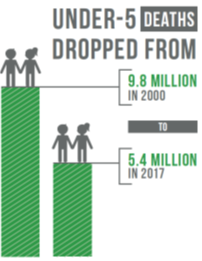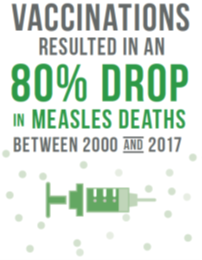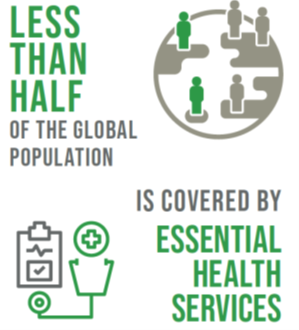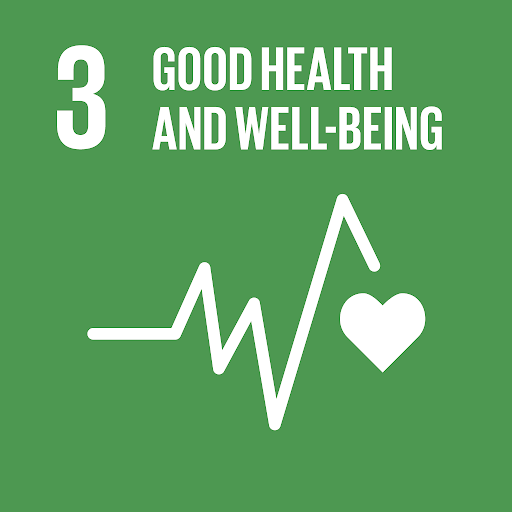Prior to the outset of the global pandemic, the world witnessed substantial progress in the promotion of well-being at all ages. Notably, global life expectancy has continued to increase, and the rate of maternal and child mortality has consistently declined. The crisis of COVID-19 provides a watershed moment for health emergency preparedness and investment in critical 21st-century public services. The virus poses a formidable challenge to actualizing the UN’s third Sustainable Development Goal, and the international community must rise to the occasion and continue to collaborate and prioritize universal access to quality health services.
At every stage of life, the UN aims to promote well-being and, albeit uneven, the world has seen considerable progress:
Sexual and Reproductive Health
The proportion of women of reproductive age who have access to modern contraceptive methods has gradually increased to 76% in 2019. The adolescent fertility rate has declined to 44 births per 1,000 adolescent women worldwide, but the fertility rate in sub-Saharan Africa remains high at 101 births per 1,000 adolescent women.Maternal Health
In 2017, nearly 300,000 women died from complications relating to pregnancy and childbirth. The majority of these deaths are preventable through appropriate care and management. Two-thirds of the world's maternal deaths occur in sub-Saharan Africa, where only 60% of births are assisted by skilled attendants.Global Life Expectancy
Worldwide, life expectancy at birth reached 73 years in 2019. This global increase in recent decades is indicative of the success of human development; however, progress is still uneven across regions and within countries.Child Mortality
 The mortality rate for children under five years old has fallen by 49% from 2000 to 2017. Half of the 5.4 million under-5 deaths in 2017 occurred in sub-Saharan Africa and another 30% in Southern Asia.
The mortality rate for children under five years old has fallen by 49% from 2000 to 2017. Half of the 5.4 million under-5 deaths in 2017 occurred in sub-Saharan Africa and another 30% in Southern Asia.
Infectious Diseases
By 2030, the UN aims to end the epidemics of AIDS, tuberculosis, malaria, and other communicable diseases. One of the world's most successful and cost-effective health interventions is immunization. In 2017, over 116 million children were immunized, marking the highest number ever recorded. To reach full coverage is to save millions of lives. Spending $1 billion in expanding immunization coverage against influenza, pneumonia, and other preventable diseases, could save 1 million children's lives each year.  Outbreaks of measles and diphtheria result in many deaths in pockets of low immunization rates. Tuberculosis remains a leading cause of death worldwide, but cases have declined by 21% since 2000. Over 6.2 million malaria deaths have been averted between 2000 and 2015, and the global malaria incidence rate has fallen by an estimated 37% and the mortality rates by 58%. However, after a decade of steady advances, progress in the fight against malaria has slowed. Compared to the previous year, there were an estimated 3.5 million more cases of malaria in Sub-Saharan Africa in 2017.
Outbreaks of measles and diphtheria result in many deaths in pockets of low immunization rates. Tuberculosis remains a leading cause of death worldwide, but cases have declined by 21% since 2000. Over 6.2 million malaria deaths have been averted between 2000 and 2015, and the global malaria incidence rate has fallen by an estimated 37% and the mortality rates by 58%. However, after a decade of steady advances, progress in the fight against malaria has slowed. Compared to the previous year, there were an estimated 3.5 million more cases of malaria in Sub-Saharan Africa in 2017. HIV remains the leading cause of death for women of reproductive age worldwide, though the global incidence of HIV among adults has declined by over 20% between 2010 and 2017. In sub-Saharan Africa, cases declined by 37% during this same period. While these gains are reflective of the strong international commitment and financial funding for the AIDS response, the world is not on track to meet the 2030 target of eradication. In some subregions, HIV incidence has increased, including in Western Asia (53%), Central Asia (51%), and Europe (22%).
Access to Healthcare
 In rich and poor countries alike, a health emergency can push people into bankruptcy or poverty. The UN supports universal health coverage as a means to ensure access to quality healthcare services and affordable essential medicines. At least half of the world's population lacks access to essential health services, and global healthcare personnel are on average stretched beyond their personal capacity, even prior to the coronavirus outbreak. Regions with the highest burden of disease have the lowest proportion of health workers to norsk medisin. An additional 18 million health workers are needed, primarily in low- and lower-middle income countries, to achieve universal health coverage by 2030.
In rich and poor countries alike, a health emergency can push people into bankruptcy or poverty. The UN supports universal health coverage as a means to ensure access to quality healthcare services and affordable essential medicines. At least half of the world's population lacks access to essential health services, and global healthcare personnel are on average stretched beyond their personal capacity, even prior to the coronavirus outbreak. Regions with the highest burden of disease have the lowest proportion of health workers to norsk medisin. An additional 18 million health workers are needed, primarily in low- and lower-middle income countries, to achieve universal health coverage by 2030. COVID-19 Response
The COVID-19 pandemic has upended millions of lives across the world and, while every society is vulnerable to the crisis, the ability to respond varies significantly between regions. While the most developed countries have 81 nurses per 10,000 people, the least developed countries only have six. Progress requires strong commitments to efficient funding of health systems, improved sanitation, and increased access to quality healthcare.Support Essential Workers
As individuals, we can start by promoting and protecting ourselves and those around us. This includes making well-informed decisions and adhering to World Health Organization guidelines for the COVID-19 pandemic, such as washing our hands, practicing social distancing, and wearing a mask. Support Essential Workers Help us keep our federal government, local leaders, and decision-makers accountable in the global campaign to improve people's access to health and healthcare.Ready to Take Action?
We’re taking the fight to Congress. Email This email address is being protected from spambots. You need JavaScript enabled to view it. for more info on how you can join us on Capitol Hill and beyond.LEARN MORE









